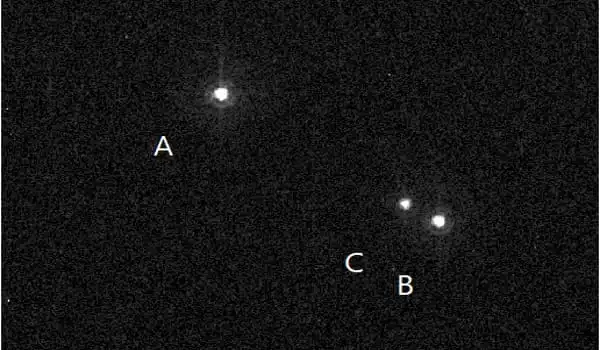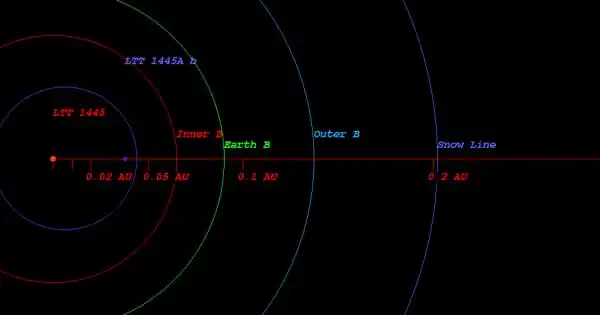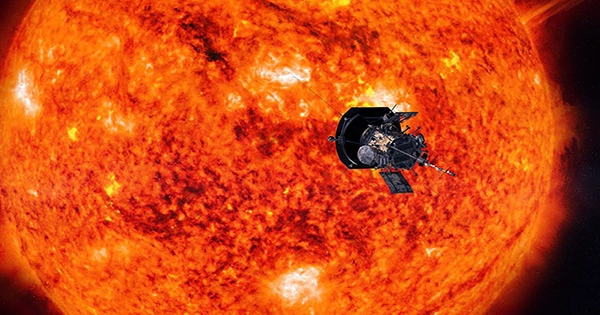LTT 1445 is a triple M-dwarf system located in the constellation Eridanus around 22 light-years away. The primary LTT 1445 A star is home to two exoplanets: one identified in 2019 that transits the star every 5.36 days, and another detected in 2021 that transits the star every 3.12 days, indicating a 12:7 resonance. It is the second nearest transiting planetary system discovered as of August 2019, after HD 219134 bc.
Stellar system
The system’s three stars are all M-dwarfs with masses ranging from 0.16 M☉ to 0.26 M☉. LTT 1445 A and LTT 1445 BC are separated by approximately 34 astronomical units and orbit each other every 250 years. The BC pair orbits each other in an eccentric orbit (e=~0.5) every 36 years. The alignment of the three stars, as well as the edge-on orbit of the BC pair, suggests that the system is co-planar. The transiting planet LTT 1445Ab shows that the entire system is co-planar, having orbits in a single plane.
LTT 1445A b is an exoplanet that orbits the star LTT 1445A, which is approximately 22.5 light-years (6.9 pc) distant from our Solar System. Its discovery was made public in 2019. LTT 1445A has an apparent magnitude of 22.0 and an absolute magnitude of 22.8. It is 0.3 times more massive and 0.3 times larger than our Sun. The surface temperature is 3340 degrees Celsius, with M spectral types. TESS light curves revealed stellar flares and rotational modulation caused by starspots, most likely on the B or C component.

Planetary system
LTT 1445Ab was identified on June 2019 by Harvard Center for Astrophysics astrophysicists using data from the Transiting Exoplanet Survey Satellite. The researchers gathered further observations, including HARPS radial velocity measurements, to constrain the planet’s mass. The planet has a steady orbit around only one host star. Because it orbits so close to the M-dwarf, the planet’s nature is most likely rocky, and its equilibrium temperature is 433+28−27 Kelvin (160 °C; 320 °F).
The super Earth exoplanet LTT 1445 A b circles a M-type star. It has a mass of 2.87 Earths, takes 5.4 days to complete one orbit around its star, and is 0.03813 AU away from it. It was discovered in 2019 and was announced.
In July 2021, the planet’s mass was determined to be 2.87±0.25 Earth masses, confirming its earthlike composition. A second planet, LTT 1445Ac, was discovered with an orbital period of 3.1 days and a mass of 1.54+0.20−0.19 Earth masses. Although it transits the star as well, its tiny size made it difficult to detect before radial velocity measurements, and it remains difficult to estimate its exact size now. The planets orbit near a 12:7 orbital resonance with one another – Ac orbiting 11.988 times for every 7 orbits Ab makes – oscillating one full orbit away from a ‘perfect’ resonance every 104 years.
















